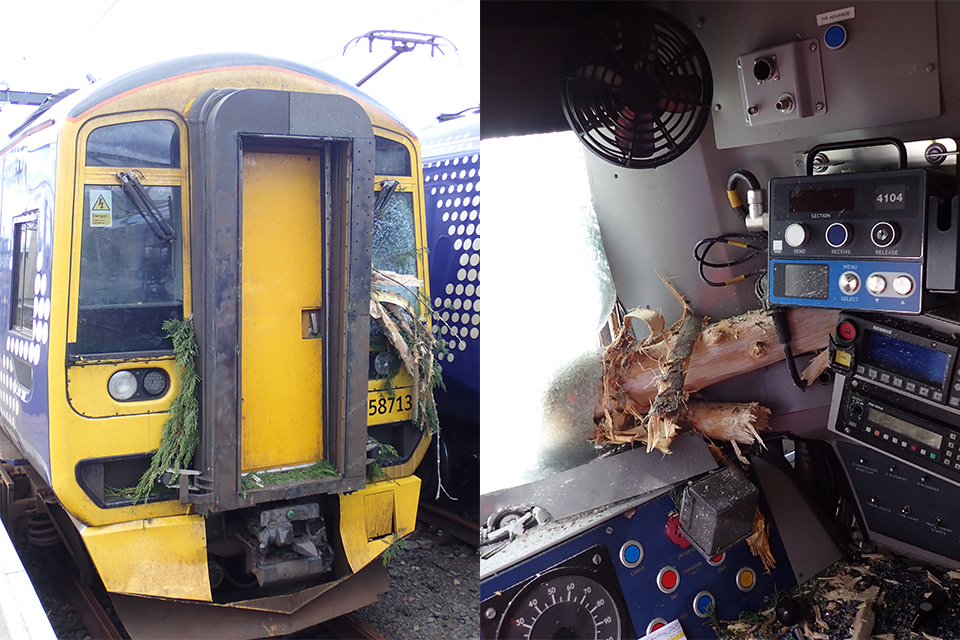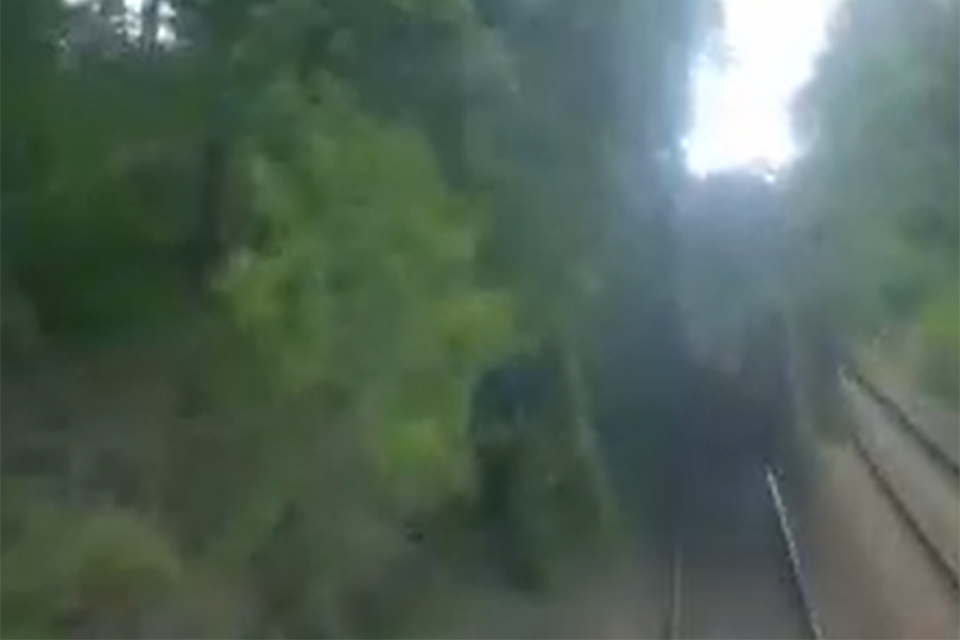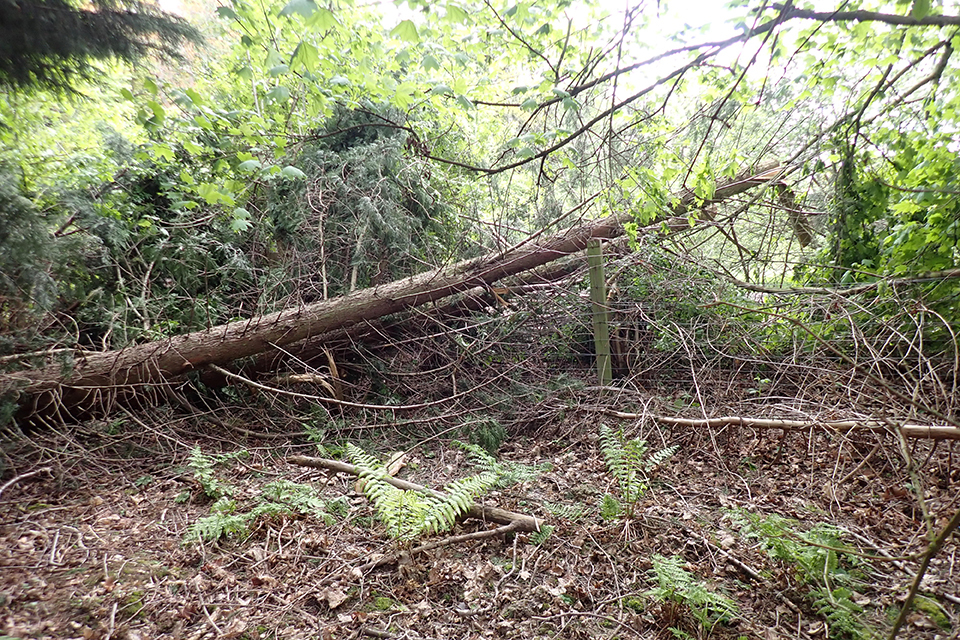Train collision with fallen tree near Glencarse, Perth & Kinross, 21 May 2021
Published 6 September 2021
1. Important safety messages
This accident demonstrates the importance of:
-
Railway authorities and owners of adjacent land having arrangements in place to manage the risk from potentially hazardous trees, including being aware of the condition of trees which may pose a risk to the safety of the railway, and taking action to manage the risk from such trees.
-
Managers who are responsible for maintenance of the lineside being aware of the timeframes for remedial action arising from vegetation inspections, and scheduling follow-up inspections where required.
2. Summary of the accident
At around 16:47 hrs, train 2L71, the 16:39 hrs ScotRail service from Perth to Dundee, struck a fallen tree while travelling at 63 mph (101 km/h). The accident occurred near the village of Glencarse, on the section of line between Barnhill and Errol.
The train had been travelling at 74 mph (119 km/h) when the tree came into view. Although the driver applied the emergency brake, the train struck the tree seven seconds later. The tree penetrated the driving cab of the class 158 unit which formed the train, and the driver sustained injuries to his head and arms. The conductor and 28 passengers on board the train were unhurt. The driver’s window and the interior of the cab were damaged, and the outer skin of two of the side windows of the train was broken.
After the train came to a stop, railway staff and passengers gave first aid to the driver, who was taken to hospital by ambulance. The train was later moved back to Perth, from where the passengers were able to continue their journeys.

Damage to the driving cab of the train
3. Cause of the accident
The previous train on the route had passed Glencarse about an hour before the accident. The tree had fallen in the intervening period, when the weather was dry, with light wind from the north-east. There had been light rain earlier in the day.
Examination of the remains of the tree, a Monterey Cypress, found that it had been growing from a base outside the railway boundary, about 11 metres from the nearest rail. The trunk of the tree had fallen some years before, and was mainly dead and rotten at the roots, but branches had grown up from the fallen trunk. These branches fell and obstructed the railway once their weight overpowered the restraining effect of the remains of the roots, and the trunk rotated as it lay on the ground. There was no evidence that the branches fell due to the direct effect of abnormal weather.

Image from the train’s CCTV showing the fallen tree immediately before the accident

The remains of the fallen tree after the accident, viewed from outside the railway boundary fence, showing the branches which had grown from the fallen trunk and which eventually fell themselves
The tree stood on a narrow strip of land between the railway and a slip road, which forms part of a junction between the A90 Perth-Aberdeen dual carriageway and local roads. The road junction was built in 1973, on land that was previously open, and it seems probable that the trees between the slip road and the railway were planted to reduce the level of noise to nearby houses from vehicles on the new road.
Network Rail has procedures for inspecting and managing trees within falling distance of railway tracks. The procedures are intended to identify ‘hazardous trees’. A hazardous tree is defined by Network Rail as ‘a tree, which may have significant defects, that poses a risk to either the railway or a third party’. Network Rail’s procedures require vegetation inspections on foot every 36 to 44 months to identify potentially hazardous trees, and from train cabs every 12 to 16 months.
The vegetation along the section of line which included the location of the accident was last inspected on foot by Network Rail staff on 3 September 2020. The inspection identified that there were various lineside trees on that section which presented a high risk to the railway, such that the owners should be notified of the inspection findings and the area re-inspected within one year. Network Rail attempted to establish if a contractor was responsible for managing that area of land, which is owned by Scottish Ministers, but it was not able to do so and no action to make the trees safe was taken before the accident occurred in May 2021. Transport Scotland has stated that the land from which the tree fell is outside the boundary of the trunk road network that it manages, and it has been unable to identify anyone who is responsible for managing the land.
The base of the tree which fell was hidden from anyone on the railway side of the boundary fence by undergrowth. The portion of the tree that was visible above the fence would have appeared healthy, and it would have been very difficult for Network Rail staff to detect that it was at risk of falling, and it is not clear from the record of the inspection in September 2020 whether this particular tree was identified. Following the accident, Transport Scotland has instructed the company which operates the trunk road network on its behalf to inspect the area and do what is necessary to make the land safe, including the removal of any further trees that may be an issue.
4. Previous similar occurrences
RAIB report 08/2011 describes a collision between a train and a fallen tree near Lavington, Wiltshire on 10 July 2010, which caused extensive damage to the train. That tree had also come from outside the railway boundary. RAIB made two recommendations directed to Network Rail. The first of these was that Network Rail should review and enhance its processes for gathering intelligence about neighbouring land where there may be a higher risk of tree fall affecting the railway. The second was that Network Rail should develop and implement a plan, or adapt and enhance existing plans, to communicate with those neighbours whose land is considered to present a high risk of tree fall affecting the railway to inform them about their responsibilities and the threat that their trees may present to the railway. The Office of Rail and Road (ORR) has reported to RAIB that these recommendations have been implemented.
On 17 October 2019 a passenger train collided with a fallen tree near Spittal, Pembrokeshire. RAIB has published Safety Digest 02/2020 describing this accident. On that occasion the tree fell from land outside the railway boundary. Network Rail’s inspections had not identified the risk from the tree, and the company had not contacted the owner of the land.
As part of its response to the Lavington recommendations, Network Rail reports that, since 2010, it has improved its knowledge of lineside trees by carrying out a national inspection in 2010/11, and using LIDAR (Light Detection and Ranging) technology to carry out an aerial survey to detect the position of trees, and apply risk models to them, between 2014 and 2016. It has revised and updated its company standard NR/L2/OTK/5201, which covers the management of lineside vegetation, to reduce the interval between tree inspections from five years to three years. It now publishes information on its website for third party landowners about their responsibilities for managing trees which may pose a risk to the railway.

